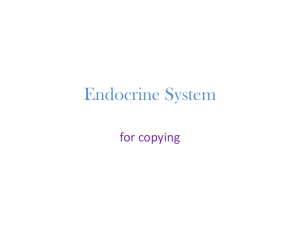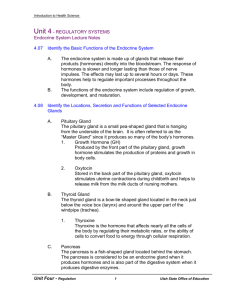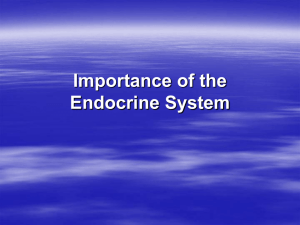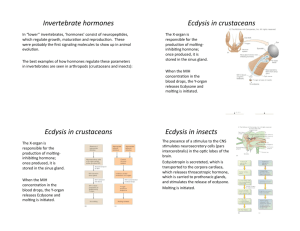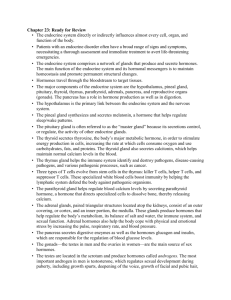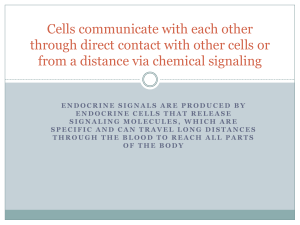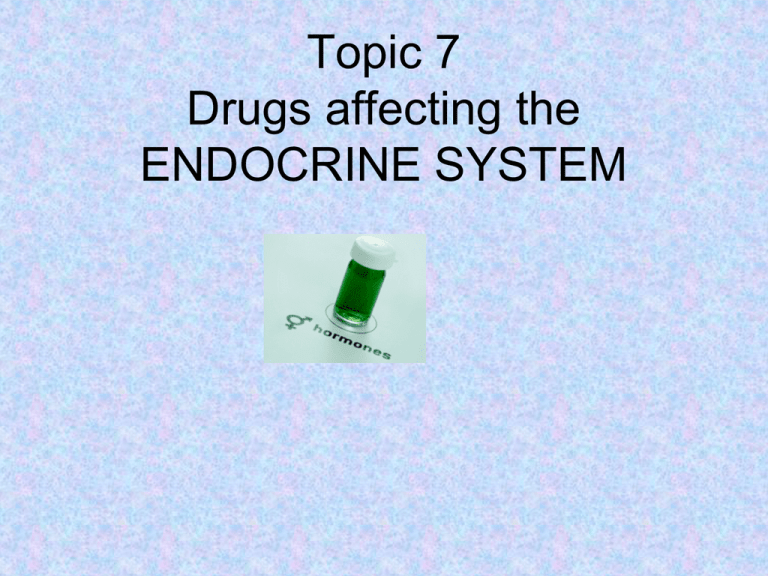
Topic 7
Drugs affecting the
ENDOCRINE SYSTEM
How Metabolism is controlled
and mediated by hormones
• Many disorders are due to either over or
under secretion of a hormones
• Endocrinology
• Can potentiate normal hormonal action
• Inhibit hormonal action.
Drugs affecting THYROID gland
• Thyroid gland produces hormones
Thyroxine and triiodothyronine which
influence growth, development and
metabolism.
• Production of these hormones depends on
the thyroid gland receiving iodine from the
body
HYPOTHYROIDISM
Decrease in thyroid activity caused by :
1. Hashimotos thyroiditis (Auto immune disorder.)
2. Myxoedema If hypothyroidism not treated
3. Iodine deficiency.
4. Radioactive iodine ingestion.
5. Atrophy of thyroid gland.
6. Surgical removal of all or part of gland.
SIGNS AND SYMPTOMS
•
•
•
•
•
•
•
Tiredness
Lethargy
Weight Gain
Intolerance to heat
Dry skin
Bradycardia
Mental impairment
HYPOTHROIDISM
NURSING IMPLICATIONS.
• Monitor symptoms related to BMR
• Monitor heart rate, reporting tachycardia
and palpitations.
• Education re life long treatment of deficient
hormones.
• Diabetics need to monitor BSL as insulin
or oral hypoglycaemics may need
increasing.
HYPERTHROIDISM
(Thyrotoxicosis)
•
Overproduction of thyroid hormone.
•
Graves Disease is an example of
hyperthyroidism. More common in
women than in men and occurs between
20-40 years of age and often arises after
emotional or physical stress or infection.
SIGNS AND SYMPTOMS
•
•
•
•
•
•
•
•
Exophthalmos
Tremor
Nervousness
Constant hunger
Weight loss
Fatigue
Heat tolerance
Palpitations
Drugs for ADRENAL CORTEX
problems.
3 Naturally occurring Groups
1. Mineralocorticoids. Electrolyte and water
balance. Natural occurring is
aldosterone.
2. Glucocorticoids. Affect fat, protein and
carbohydrate metabolism and also have
an anti-inflammatory effect.
3. Gonadocorticoids, sex hormones.
Mineralocorticoids
• These drugs primarily responsible for
regulating sodium and potassium in the
body.
• Treat adrenocortical insufficiencies.
• Potent immunosuppressants, prevent
organ transplant rejection
• Lung maturation in premature infants
• Aldosterone, causes Sodium and Water
retention increases blood volume and BP
• Fludrocortisone (Florinef)
GLUCOCORTICOIDS
• Classified according to their duration of
action
• Increases blood glucose, mobilizes fats,
stimulates protein catabolism, depresses
immunity, and inflammatory responses.
• Natural = Hydrocortisone
• Synthetic = All others, prednisone
Examples
•
•
•
•
•
Betamethasone
Dexamethasone
Prednisone
Flixotide
Betnovate cream
Effects
•
•
•
•
•
•
•
•
Euphoria, psychiatric problems
Fluid retention, electrolyte imbalance
Delayed wound healing, bruising, acne
Fungal infections exacerbated
Hyperglycaemia, insomnia
Increased appetite, obesity
Osteoporosis (long term effect)
Cushings syndrome (Metabolic disorder
resulting from chronic and excessive
production of cortisol by the adrenal cortex.
CUSHINGS SYNDROME
SIGNS & SYMPTOMS
1. Moon Face
2. Buffalo hump
3. Depression
4. Anxiety
5. Menstrual irregularities
6. Acne
Nursing Implications
•
•
•
•
Monitor BP
Inhaled steroids, wash mouth
IMI deep
Not withdrawn immediately, tapered over
at least 2 weeks
• BSL monitoring
• Taken with food
Gonadocorticoids
Oestrogen only preparations
– Replacement (menopause)
– Morning after pill
• Induces uptake of Ca into bone, therapy
for menopausal women with osteoporosis
• S.E. = breast tenderness, Fluid retention,
thrombosis
Gonadocorticoids
Progesterone only preparations
• Suppress ovarian function
• Mini pill
• S.E. similar to Oestrogen only symptoms
Gonadocorticoids
• Oral contraceptives
• Combination
• S.E. thromboembolism, heart disease,
CVA, liver disease
Gonadocorticoids
• Androgens (testosterone),
• Treat deficiencies.
• Nandrolone, a anabolic androgen,
Produces masculinising effect
Drugs used in disorders of the
PANCREAS
• When the pancreas no longer secrete
sufficient effective insulin the glucose
cannot enter the cells.
• NIDDM, IDDM, Glucogon.
• Glucagon acts on the liver to increase
blood glucose levels by stimulating the
breakdown of glycogen into glucose, and
amino acids and free fatty acids
INSULIN
•
•
•
•
IVI, S/C, IMI (rare).
Short medium or long acting.
Observe for Hypoglycemic episodes
Requirements may vary with pregnancy,
infections, stress,
• Never change type quickly.
HYPOGLCEMIA
Do you know the signs and
symptoms of a “hypo” ?
Oral Hypoglycaemic agents
2 types
• Sulfonylureas, (Daonil)
1: Stimulates insulin secretion
2: inhibits gluconeogenesis (forming glucose from
amino acids and fatty acids)
3: increases the number of insulin receptors in the
target cells
• Biguanide, (Metformin) acts by promoting
glucose uptake into cells .
• Used in precaution with renal disorders
Nursing Implication
• Monitor BSL
• Reduced tolerance to alcohol and need
to restrict intake
• Pt to carry medi alert tag
• Educate family
• Monitor liver enzymes
Drugs used on disorders of the
PARATHYROID
• Calcitonin (Decreases) (thyroid) and
parathyroid (Increases) blood Calcium.
• Calcitonin inhibits bone reabsorption
• S/E dose related nausea and vomiting,
local inflammation at inj site, alopecia,
headache, Oesopageal pain,
• Alendroate (Fosamax), increases Ca level.
Avoid laying flat ½ hour after ingestion
Posterior Pituitary Hormones
• Antidiuretic Hormone (ADH) Vasopressin
• Cannot be administered orally.
• Oxytocin, smooth muscle stimulant, used
to initiate labour.
• Oxytocin
Identification of Drugs
•
•
•
•
•
•
Daonil
Actrapid
Prednisilone
Metformin
Syntocinon
Thyroxin
Identification of Drugs
•
•
•
•
•
Tolbutamide
Gliclazide
Dexamethasone
Humalin 70:30
Pulmicourt



